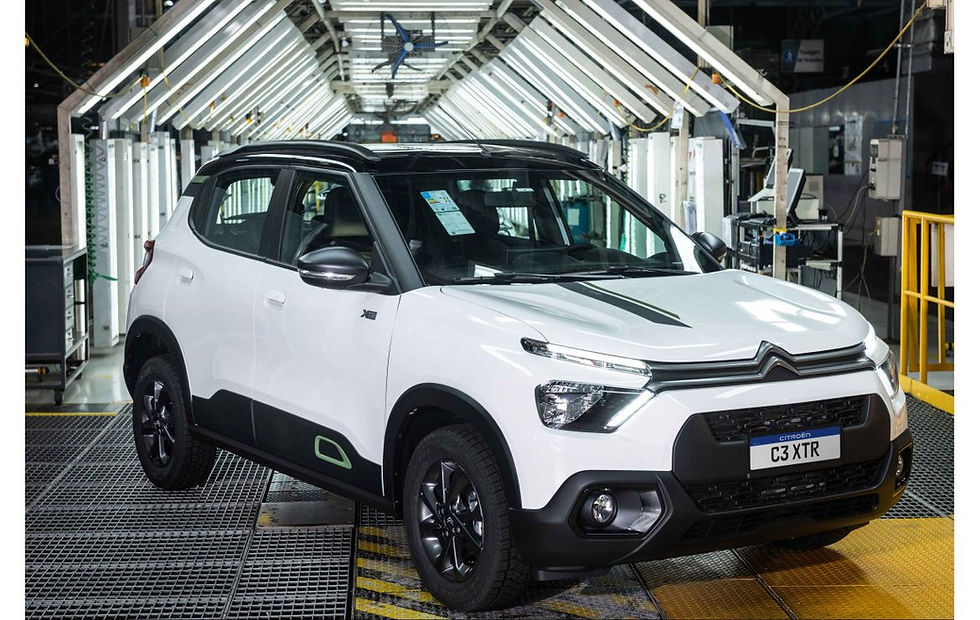Citroën C3: its success confirmed in Europe
- Jérémy

- May 29
- 4 min read

Since its launch a few months ago, the new generation of the Citroën C3 has consistently posted encouraging sales figures across Europe, marking a notable improvement over its predecessor. After a somewhat subdued performance in March, the chevron-branded city car significantly picked up pace in April in the European market, confirming the positive reception for this strategic model. These results are all the more closely watched as the C3 competes in a particularly competitive and rapidly evolving B-segment.
The Citroën C3 confirms its momentum, securing a spot in Europe's Top 5
April 2025 proved to be a particularly prosperous month for the Citroën C3 on the Old Continent. With 16,113 units registered, it recorded a 7% growth compared to April 2024. This figure, already positive in itself, takes on an even more impressive dimension when put into perspective: it follows an April 2024 where the previous C3 generation had already achieved a spectacular 98% jump in sales. Maintaining an upward trajectory on such a high comparison basis testifies to the relevance of the new C3 offering and its ability to attract a wide customer base.
This performance allows the Citroën C3 to clearly distinguish itself from its main competitors in the B-segment, a traditionally hotly contested market. Indeed, while the C3 is progressing, other benchmarks are taking a hit: the Dacia Sandero, often a sales leader, saw its registrations fall by 28% in April 2025. Similarly, the Renault Clio recorded a 3% decrease, while the Peugeot 208, another heavyweight in the segment, experienced a 6% decline. In this context, the C3's growth is a strong signal. Thanks to these excellent results, Citroën's city car climbed to a very respectable 5th position in the overall passenger car sales ranking in Europe for April. Even more significantly for the brand, it secured the 4th spot in its segment's sales. Such a position in the European charts is a noteworthy achievement and relatively rare for Citroën in recent years, highlighting the success of the product strategy around this flagship model.
The ë-C3 forges its path in the electric market, despite a specific french context
The arrival of the all-electric version, the Citroën ë-C3, was anticipated as a sales catalyst and a marker of the brand's commitment to the energy transition. In April 2025, the ë-C3 found 3,962 buyers in Europe, placing it 10th in electric vehicle sales. These volumes represent a quarter of the C3's total sales, a significant ratio for a launch, demonstrating the interest in this zero-emission alternative. In the specific segment of electric B-Hatchbacks (versatile city cars), the ë-C3 even ranks as the second best-seller, an excellent start.
Comparison with the Renault R5 electric, its direct competitor newly arrived on the market, is inevitable. The R5 registered 5,662 units, placing it sixth in electric vehicle sales. However, a closer analysis reveals a different geographical dependency for the two models. While the Renault R5 achieves 40.04% of its sales in its French home market, the Citroën ë-C3 shows a more balanced distribution, with 26.65% of its European registrations made in France. This lesser dependence on the domestic market suggests a more homogeneous penetration of the ë-C3 across various European countries.
It is important to note that the ë-C3's launch in France coincided with significant discussions on social media and in parts of the specialized press regarding some initial software bugs. Although quickly addressed by the brand, these reports may have impacted the model's initial perception in its home market, where the R5, benefiting from high anticipation and a very positive image, took a notable lead. The fact that the R5 outsells the C3 overall in Europe is therefore largely attributable to this strong performance in France, as figures suggest the ë-C3 is performing very well, if not better, in other European markets. The ë-C3's performance outside of France is thus a key indicator of its growth potential as its reputation builds and positive customer feedback becomes more widespread.
It is remarkable that the new Citroën C3 not only successfully takes over from its predecessor but also improves upon its performance. The previous generation experienced what could be described as a phenomenal first half of 2024 in terms of sales. It would have been reasonable to assume that this exceptional success would set a very high bar for the new iteration and could even hinder its initial progress. However, this is not the case. The new C3 is doing better, showing significant growth even though the 2024 comparison base was already extraordinarily high and its main competitors are showing signs of slowing down.
These excellent commercial performances are all the more encouraging as they are currently achieved without the contribution of the hybrid version. This powertrain, which combines petrol and electric assistance, is currently the most popular choice among European buyers in many segments, thanks to its balance of efficiency, versatility, and running costs. The upcoming arrival of the C3 Hybrid should therefore logically provide an additional boost to sales. With a complete and competitive range, including efficient petrol engines, an accessible electric version, and soon a highly anticipated hybrid, the question arises: does the Citroën C3 have what it takes to aim even higher and, why not, become the best-selling car in Europe? Only time will tell, but current signals are decidedly optimistic.






Comments